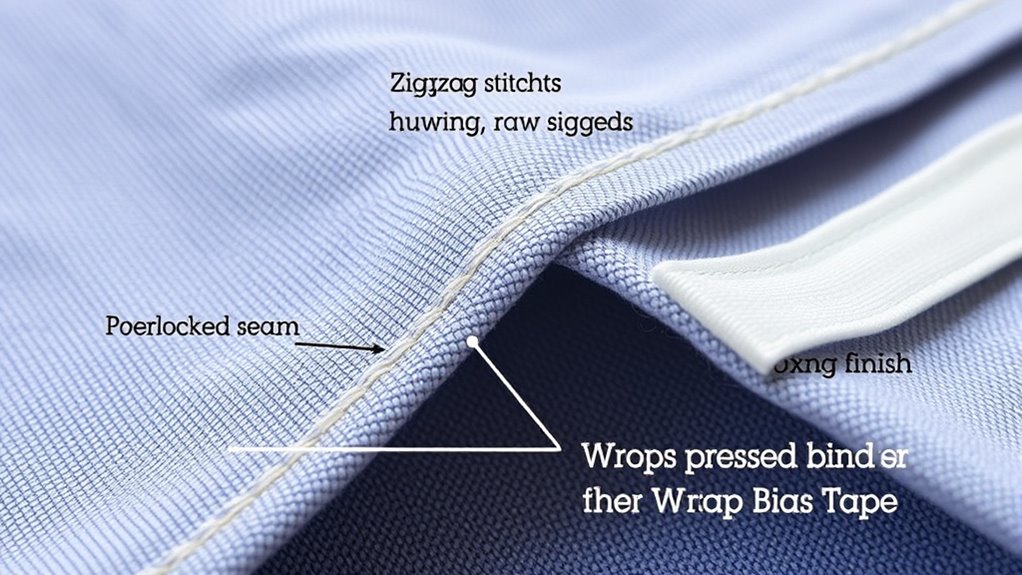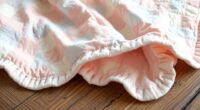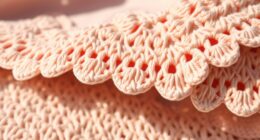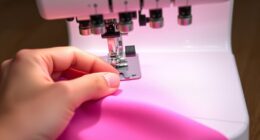To prevent fraying, you can use several seam finishes. A zigzag stitch encases raw edges and is quick to do. An overlock or serger finish trims and encloses edges for a professional look. Hong Kong binding involves sewing bias tape over raw edges for durability. Other options include pinking shears for a zigzag cut or French seams for a clean inner finish. Stay tuned to discover how each method can help your sewing projects last longer.
Key Takeaways
- Use zigzag stitches along raw edges to securely encase fabric and prevent fraying.
- Apply overlock (serger) finishes to trim and enclose raw edges for a professional, durable seam.
- Bind raw edges with bias tape or fabric strips using a Hong Kong finish for a neat, fray-resistant edge.
- Press fabric edges before sewing and test finishes on scraps to ensure proper tension and stitch strength.
- Combine seam finishes with proper fabric preparation to extend garment lifespan and maintain a tidy appearance.

Seams can easily fray over time, especially with frequent washing or stretching. To prevent this, you need to pay attention to seam finishes that secure the raw edges. Before you start, verify you have the right sewing machine settings and proper fabric edge preparation. Adjust your sewing machine to a zigzag stitch or a narrow overlock stitch, depending on the finish you choose. Setting the stitch length and width correctly is essential; for zigzag, a medium width and length often work best, but always test on scrap fabric first. Proper fabric edge preparation involves trimming excess fabric and pressing the edges to create a clean, flat surface, making it easier to sew neat finishes that won’t fray easily. Incorporating natural materials like linen or cotton in your sewing projects can also help reduce fraying, as these fibers tend to hold their edges better when finished properly.
Protect your seams by choosing the right finish and preparing fabric edges carefully.
A zigzag stitch is one of the simplest methods for preventing fraying. When you sew along the raw edge with a zigzag pattern, the stitches encase the fabric edge, adding a flexible barrier that resists unraveling. To get the best results, make sure your sewing machine is set to a tight zigzag stitch, and sew just inside the raw edge, catching enough fabric to hold it securely. This finish is quick, versatile, and works well for most woven fabrics. For stretch fabrics, you might want to use a stretch stitch or narrow zigzag to maintain flexibility.
Overlock or serger machines provide a professional, durable finish that trims and encloses the raw edge simultaneously. If you have access to one, it’s a game-changer, especially for garments that will endure frequent washing. When setting up your overlock machine, select the appropriate stitch type and tension for your fabric. Proper fabric edge preparation, such as trimming and aligning edges precisely, ensures the overlock stitches sew smoothly along the edge, creating a clean, fray-proof seam. If you don’t own a serger, you can mimic its effect using a zigzag or a specialized seam finish like the mock overlock stitch on some sewing machines.
Another excellent option is the Hong Kong finish, which involves binding the raw edge with a narrow strip of fabric or bias tape. This method requires careful fabric edge preparation—trimming the edge evenly and pressing it before attaching the binding. Sew the tape over the raw edge with a straight stitch, then fold it over to encase the edge entirely. This finish not only prevents fraying but also adds a polished look to your project. Whichever finish you choose, always check your sewing machine settings, prepare your fabric edges properly, and test your stitches on scrap fabric first. Doing so guarantees your seams stay intact longer, keeping your sewing projects looking neat and professional over time.
Frequently Asked Questions
Which Seam Finish Is Best for Stretch Fabrics?
For stretch fabrics, you should use a serger or overlock stitch because it provides excellent seam flexibility and prevents fraying. This finish allows the seams to stretch with the fabric, maintaining durability and comfort. Avoid traditional zigzag finishes on very stretchy materials, as they may not be as strong or flexible. Using an overlock guarantees your garment stays intact and looks professional, even after multiple washes.
How Do I Choose a Seam Finish for Delicate Fabrics?
When choosing a seam finish for delicate fabrics, you should consider options that provide gentle fabric edge protection without causing damage. Seam finish options like French seams or narrow hems are ideal, as they encase raw edges and prevent fraying while maintaining a soft, delicate feel. These finishes are perfect for fragile fabrics because they offer durability and a polished look without adding bulk or stress to the material.
Can Seam Finishes Be Applied After Sewing?
Yes, you can apply seam finishes after sewing, but it’s best to do so promptly to guarantee durability and aesthetics. Using methods like zigzag stitching or hand overcasting can reinforce the seam, preventing fraying over time. Applying seam finishes later might be less effective than during initial construction, but it still improves seam durability and keeps your project looking neat. Just make sure to choose the right finish for your fabric type.
Are Seam Finishes Suitable for All Types of Sewing Projects?
Seam finishes are suitable for most sewing projects, with studies showing they extend seam durability by up to 40%. You should consider fabric types—delicate fabrics like silk benefit from specific finishes, while sturdy materials like denim may not require them. Using seam finishes helps prevent fraying and ensures your seams stay intact longer, making your project more professional and durable, regardless of the fabric you choose.
How Do Seam Finishes Affect Sewing Machine Maintenance?
Seam finishes can impact your sewing machine maintenance by affecting thread tension and needle wear. When you use certain finishes like overlock stitches, you may notice increased tension adjustments or more frequent needle replacements. Always check your thread tension regularly and replace needles as needed to prevent skipped stitches or damage. Proper maintenance guarantees your machine handles seam finishes smoothly, keeping it in good condition for all your sewing projects.
Conclusion
Now that you know these seam finishes, you’ll be able to keep your sewing projects neat and durable like a fortress guarding its treasures. Whether you choose zigzag, overlock, or Hong Kong finishes, each method acts as a shield against fraying. Think of them as the armor your seams need to stay strong through countless washes and wears. With these techniques, your sewing skills will shine, and your creations will last like a timeless masterpiece.









